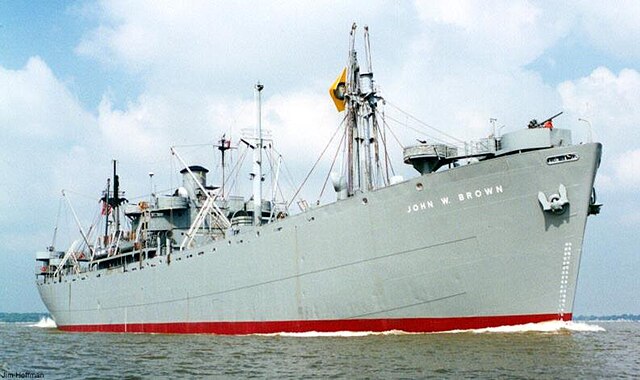
How did America build so many Liberty ships in World War 2? They could build so many because of the way the ships were built, new technologies, their infrastructure, and their resources.
Liberty ships were cargo ships that were built by the United States during World War 2. They were originally designed by J. L. Thompson & Sons in the UK, but they were coal fired ships. The UK had a large number of coal mines and easy access to coal, but no real access to oil. When the US started building them, they adapted the design to make it easier to build and to make the engines oil fired because they had more oil than Britain did. They were used as cargo ships to carry men, arms, supplies, and anything that the war effort needed, all over the world. They could carry 10,000 tons of cargo and travel at 11 knots, which is about 20 km/h. They were not very attractive ships and President Roosevelt called them “dreadful looking objects.” They were nicknamed “ugly ducklings” by the press, but they did the job they were built for and they were very easy to build. Throughout the war, between 1941 and 1845, 2,710 Liberty Ships were built across 18 American shipyards. Out of all these ships, only 200 of them were sunk, which is a testament to how good they were.
So, how was the US able to build 2,710 ships in four years? There are several reasons. The first reason is the design of the ship. Before the Liberty Ship, most ships were built entirely in the yard from the bottom up. That takes a long time. The Liberty ships were built in sections and assembled in the ship yard. Parts of the ships were put together in other areas and moved to the shipyards to be assembled. This was a new way of doing things and it made it possible to build the ships much more quickly. However, it took a while to get the infrastructure in place to be able to do this. The first Liberty Ship took 230 days to build because all of the technology and systems were not in place. Once people worked out how to build the ships properly, the rate to finish a ship dropped to an average of 39 days by 1943. The record for building a ship was 4 days and 15.5 hours! That was a publicity stunt, though.
The second reason they could build Liberty ships so quickly was because of the new technology of welding. Wooden ships had been constructed with nails and when metal ships became possible, the sheets of metal were joined together with rivets. It takes a long time to completely rivet a whole ship. During World War 2, welding became possible. It is much faster and easier to weld two plates together than it is to rivet them. However, one thing that wasn’t known until later was that badly welded metal can cause cracks when the metal is put under stress, such as when it contracts in a cold sea. This is called brittle fracture and some of the 200 ships that sank went down because of this.
The third reason is because of America’s impressive infrastructure. It was only possible to make the ships in pieces and assemble them in shipyards because of America’s rail and road networks. Without those, the US wouldn’t have been able to turn out so many of the ships.
The fourth reason is the amount of resources that America had access to. The steel for the ships had to come from somewhere and no other country had the capacity to produce so many ships. The US made a lot of steel, but scrap metal was also heavily used as well. The oil to power the ships was also a resource that the US had in plenty. Lack of resources is one of the reasons why Germany couldn’t sustain the war and Japan invaded the rest of Asia. However, possibly more than the natural resources, it was the human resources that the US could bring to bear that were the most important. There were 18 major shipyards and each one employed about 50,000 men and women. By the end of the war, 1.5 million people had been trained to build Liberty ships. No other country could have done that and no other country could have made as many ships as quickly as the US. And this is what I learned today.
Image By Project Liberty Ship, Attribution, https://commons.wikimedia.org/w/index.php?curid=3264194
Sources
https://americanhistory.si.edu/collections/nmah_842604
https://en.wikipedia.org/wiki/Liberty_ship
https://www.quora.com/How-did-the-US-build-ships-so-fast-in-World-War-II
https://www.goldenarrowresearch.com/wp-content/uploads/2020/05/History-of-WWII-Merchant-Marines.pdf
